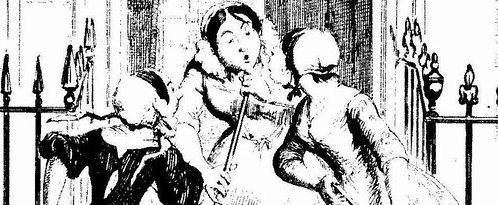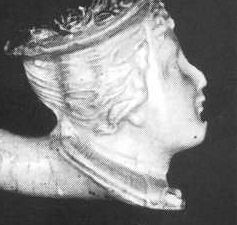What's your cup?
To the Victoria and Albert today - and one of those annoying times when I was waiting to meet someone while they were waiting somewhere else. (He didn't have a mobile - still this must have happened an awful lot more before they existed ... )
So I spent the afternoon with the Tudors - something I should have done long before; I've had a bit of a mental block on the V&A and the whole "decorative arts" business: I spent too much of my childhood being dragged around antique shops that bored me silly. (Odd that seems now, but there were never any stories attached to things, only prices.)
The collection of textiles is truly astonishing. Not perhaps the royal stuff - that the marriage suit of James II should have survived, albeit without the waistcoat, is no great shock, but I was impressed by some of the humbler costumes, such as the embroidered lying-in smock dating back to 1630 using patterns from A Schole-house for the Needle by Richard Shorleyker (1624) and the jacket of Margaret Laton, whose portrait also survives.
I was also taken by a posset cup, looking rather more like a teapot, but with the spout instead meant as a straw. The V&A example looks not unlike this one, although not quite so elaborate. The V&A said that these were used for "warm nutritious drinks, often given to women after birth: milk beaten with eggs, sugar and spices and curdled with ale or sherry".
It hardly seems that women would have these just for the odd occasion they needed them, so I wondered if they might not be part of a midwife's kit, at least among midwives catering to the higher classes. Anyone come across this?
There's more about possets, and a recipe, here. Not altogether sure about sherry AND ale in it - otherwise it is more or less an alcoholic egg nog, which sounds fine to me. This article suggests these were not for new mothers, but rather for convivial suppers, with the liquor drunk from the spout and the "custard" eaten from the top.
According to this ballad, it certainly was ceremonial fare ...
The candles being light againe,
And things well and quiet,
A goodly posset was brought in
To med their former diet.
Then Robin for to have the same
Did turn him to a beare;
Straight at that sight the people all
Did run away for feare.
While in my cups, I also learnt another new term: fuddling cup. The root of the term is the same as "befuddled", and was an elaborate drinking joke, of the "fart cushion" sort that I suspect the Tudors would have found hilarious, and us in general less so.
Several vessels were linked together in a ring and the drinker would have required greater manual dexterity than is common late in the evening to end up with the liquid in his mouth rather than on his shirt. (There's an example here.)
A reminder of other differing sensibilities comes in the locket commemorating the birth of John Monson in 1597. Annoyingly, as in the case of many other characters in the gallery, the V&A tells you no more about him - a little biography please! He presumably is the same John Monson reported on this website as marrying Ursula Oxenbridge in 1627 and had a son John, later "Sir John" in the following year. He was the grandfather of the "1st Lord Monson" (b. 1693).
Nothing unusual in that, you might say, except this heart-shaped locket was made to hold the caul, which covered the baby's head when he was born. It was dried and placed in it. That's what you call a personal momento.
History







3 Comments:
I'd have to look this up but I think the birth caul had quite a bit of significance - a lucky charm, used in magical spells, that kind of thing. I have a feeling it gets a mention in David Cressy's book on Birth, marriage and death rituals.
I was thinking the same thing, Sharon. As it's rather unusual for a baby to be born in its caul (usually the amniotic membrane is broken in labor or delivery), such a circumstance could be taken as a sign that the child had a special power or destiny. One such belief I've seen mentioned (google "born in the caul") is that the caul protects a person from drowning--so long-ago sailors apparently purchased dried cauls as a bit of insurance.
Yes, it was supposed to be a sign of luck, or at least potential power. (There's a bit about that on the bottom part of the definition to which I point in the "caul" link.) But I don't think we'd really like to wear it - even dried - around our necks!
Post a Comment
<< Home